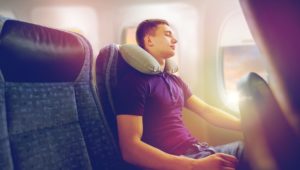Jet Lag: Navigating Symptoms, Causes, & Prevention
- Jet lag is a circadian rhythm sleep disorder that occurs when a person’s internal circadian clock is out of sync with the time zone they are in.
- Common jet lag symptoms include fatigue, insomnia, irritability, and digestive problems.
- The circadian clock takes about 1-1.5 days to adapt per time zone crossed. Light is the only environmental time cue that can reset the clock as quickly as possible.
Long-distance plane travel is infamous for being inconvenient and uncomfortable. Due to the logistics of check-in, the stress of security lines, and hours being stuck in a confined space, many people find extended plane trips to be seriously taxing.
Jet lag frequently contributes to the physical burden of long flights. Jet lag can throw off your sleep and cause other bothersome symptoms that persist for days or even weeks after a flight. Whether you’re traveling for business or pleasure, understanding jet lag can make long-distance trips more pleasant and less disruptive to sleep and overall health.
What Is Jet Lag?
Jet lag is a circadian rhythm sleep-wake disorder that occurs when your 24-hour internal clock does not match the local day-night cycle.
Under normal circumstances, a person’s circadian clock promotes alertness during the day and sleep at night. In addition to sleep, this internal clock controls multiple biological processes including mood, performance, hormone release, metabolism, and immune function, among many others. The clock, and the rhythms it controls, are synchronized by the 24-hour light-dark cycle to promote normal function and good physical and mental health. When someone travels across many time zones quickly, the circadian clock cannot reset to the new light-dark cycle quickly enough, causing jet lag.
Jet leg generally happens when a person travels east or west across three or more time zones. For example, if you fly from Los Angeles to New York and arrive at 11 p.m., your body might still operate as if it’s in L.A. at 8 p.m. and make it hard to fall asleep at the normal time in New York. This jet lag can cause you to stay up later than you’d like, sleep at odd hours, or feel more tired than usual, among other symptoms. It will also make it hard to wake up in the morning. When you try to wake up at 7 a.m. on New York time, you body will still think it is 4 a.m.
Is Your Troubled Sleep a Health Risk?
A variety of issues can cause problems sleeping. Answer three questions to understand if it’s a concern you should worry about.
Symptoms of Jet Lag
The most common symptoms of jet lag include:
- Sleeping problems: It may be hard to fall asleep when you want to, or you may wake up earlier than planned. Jet lag can also cause sleep to be fragmented.
- Daytime sleepiness: Jet lag frequently causes you to feel drowsy or tired during the day.
- Impaired thinking: You may experience problems with attention or memory or simply feel like your thinking is slowed.
- Hampered physical function: Your body may feel tired, and peak physical performance may be affected, which is especially notable for traveling athletes.
- Emotional difficulties: Some people with jet lag feel irritable, and evidence indicates that jet lag can exacerbate mental health problems , such as mood disorders.
- General malaise: Jet lag may make you feel malaise , which is a general feeling of discomfort, illness, or uneasiness
- Stomach problems: Jet lag can induce gastrointestinal problems like reduced appetite, nausea, or even constipation and irritable bowel syndrome .
These symptoms arise after long flights to different time zones because of misalignment between your internal circadian clock, which is still on the old time zone, and the timing of your behavior on the new time zone, which then affects sleep and other bodily processes.
People with jet lag experience one or more of the symptoms listed above. Symptoms can begin immediately or set in a few days after arrival. Many people sleep well the first night after a flight due to fatigue only to encounter sleep problems in the following days.
Jet lag lasts anywhere from a few days to a few weeks . In general, symptoms persist for 1-1.5 days per time zone crossed, but the duration of symptoms varies depending on the person and their trip details.
Can Jet Lag Have Long-Term Consequences?
Jet lag is usually a short-term problem that goes away once the body’s circadian rhythm has adjusted to the local time. For people who frequently take long-distance flights, such as pilots, flight attendants, and business travelers, jet lag can become a chronic problem .
A chronically out-of-sync circadian rhythm can create persistent sleep problems that may give rise to insomnia. A healthy internal clock is important for the overall health of the body , therefore chronic circadian rhythm disruption may raise the risk of disorders like diabetes and depression as well as some types of cancer .
Causes of Jet Lag
Not everyone who takes a long-distance flight gets jet lag. Multiple factors influence the likelihood and severity of jet lag:
- Trip details: The total distance, amount of layovers, time zones crossed, direction of travel, local daylight hours, length of time at the destination, and other specifics of a trip can affect jet lag.
- Arrival time: When you arrive at your destination may affect how quickly you can adapt your circadian rhythm, as the light when you arrive may shift you in the wrong direction. For example, for eastward travel from US to Europe, seeing light when you land in the morning will shift you in the wrong direction. Therefore, jet lag may be reduced with afternoon arrivals .
- Age: A person’s age may play a role in jet lag, although studies have found mixed results. People over 60 experience circadian changes that can make it harder for them to recover from jet lag , but some research in pilots found jet lag to be worse in younger people .
- Sleep before travel: Poor sleep in the days leading up to a flight can increase a person’s propensity for jet lag after traveling.
- Stress: Being stressed-out can keep the mind and body on-edge in ways that interfere with sleep and make it harder to cope with with the sleep disruption associated with jet lag.
- Use of alcohol and caffeine: Many people drink alcohol and coffee during flights, and these substances affect the brain in ways that can disrupt sleep.
Because there are many factors involved, it is hard to know exactly who will develop jet lag, how severe it will be, and how long it will last. However, it is common for at least mild jet lag to occur when more than three time zones are crossed during flight.
Symptoms may be more pronounced as more time zones are crossed. Jet lag does not occur on north-south flights that do not cross multiple time zones. Roughly 75% of people find that jet lag is worse when traveling east than it is when traveling west , although jet lag differs with the direction of travel based on each individual’s internal circadian clock.
How is Jet Lag Different From Travel Fatigue?
It’s normal to feel wiped out after you’ve had a long travel day. While this can be confused with jet lag, it’s often a result of travel fatigue . Travel fatigue includes symptoms like tiredness and headaches that can arise because of the physical toils of travel.
Airplane cabins, which have cool, dry, low-pressure air, can cause dehydration and susceptibility to respiratory problems . Air pressure changes can lead to bloating, and long-term sitting can cause leg swelling. It’s often difficult to sleep upright in an airplane seat, especially with in-flight interruptions, so getting quality rest in transit can be challenging.
Unlike jet lag, travel fatigue does not involve circadian rhythm disruption. For that reason, while travel fatigue usually goes away after a good night’s sleep, jet lag can persist for days or weeks until a person’s internal clock becomes realigned. It is possible to have both travel fatigue and jet lag after a long-haul flight, but jet lag is far more likely to cause lasting and extensive symptoms.

How Can You Prevent or Reduce Jet Lag?
Jet lag can have ruinous effects on a vacation, business trip, or athletic competition. As a result, travelers of all kinds strive to minimize the effects of jet lag. The key to preventing and reducing jet lag is quickly realigning your circadian rhythm to synchronize with the time zone of your destination.
For very short trips, you may be able to avoid jet lag by scheduled activities, including sleep and meals, to keep your circadian rhythm aligned with your home time zone, although your work schedule will often get in the way. In this way, you avoid circadian disruption both during the trip and after you’ve returned home. However, this is difficult to do.
For travel lasting longer than an overnight trip, minimizing jet lag requires acclimating to the day-night cycle at your destination. The following sections address methods of reorienting your circadian rhythm and practical tips for reducing jet lag.
Light Exposure
Light is the most powerful influence on circadian rhythm, and strategic light exposure may help adjust your internal clock to avoid or reduce jet lag.
Indiscriminate light exposure, or simply following the day-night cycle in the new time zone, doesn’t resolve jet lag and could make your jet lag worse because the timing of light exposure and light avoidance are critical. Light exposure can either advance or delay your internal clock based on the timing and unfortunately knowing the right time is not intuitive.
Properly timed periods of both daylight and darkness can help sync your circadian rhythm with local time. When access to natural light is limited, bright indoor lights, your phone or computer, or even light therapy lamps, can deliver light exposure that will influence your circadian clock.
Melatonin and Sleep Aids
Melatonin is a hormone that the body produces that helps to both make you feel sleepy and govern your circadian rhythm. Melatonin normally starts to be produced in the evening, a few hours before bedtime, and is only released at night, but this rhythm can get thrown off by jet lag.
Depending on the country of travel, melatonin is available by prescription or as a dietary supplement. Low-dose melatonin can help reset the clock and may help with sleep if taken at the right time. Like light, melatonin can shift the clock either earlier or later, so timing is crucial . Make sure to ask your doctor before taking melatonin for the first time in case of unexpected reactions.
Other types of sleeping pills, including prescription and over-the-counter drugs and natural sleep aids, may help you fall asleep or stay asleep, but they do not work to change your circadian rhythm. In some cases, they may even mask an ongoing case of jet lag. Sleep aids can also have side effects, including a heightened risk of falls and accidents if they increase drowsiness. It’s best to consult with a doctor, ideally prior to your trip, to discuss the benefits and risks of sleep aids relative to your specific situation.
Pre-Adapting Your Internal Clock
Modifying your sleep schedule in the two days leading up to your trip can be beneficial, so that when you arrive at your destination, there is less of a discrepancy between your circadian rhythm and the local time.
In addition to changing your bedtime, this approach often involves carefully timed melatonin and light exposure to proactively alter your circadian rhythm. While this approach may be beneficial in some cases, it may not be practical depending on your daily schedule, and professional, family, and social obligations.
Creating a Plan for Overcoming Jet Lag
The optimal plan to avoid jet lag depends on many factors including the direction of your flight, the number of time zones crossed, how long you will remain at your destination, and your schedule and obligations during your trip.
Taking these factors into account, you can create a personalized plan to reduce jet lag. Light can help you realign your circadian rhythm, but the timing is not intuitive and it’s easy to get it wrong.
A doctor, travel nurse, or sleep specialist may be available to help you prepare a plan for managing jet lag. Several online resources and apps can help you generate tailored schedules to help reduce jet lag based on your trip details.
Practical Tips for Reducing Jet Lag
A number of practical tips for before, during, and after your flight can help reduce sleep disruptions and travel fatigue so that you make the most of your trip.
Before Traveling
- Schedule the first days of your trip: Make sure to give yourself time to sleep and follow your plan for light exposure. Build buffers into your schedule just in case you feel sluggish, and if possible, try to arrive days in advance of an important meeting or event so that you have time to acclimate.
- Minimize travel stress: Don’t wait until the last minute to pack or leave for the airport. Being in a rush can heighten stress and make your travels more difficult.
- Get quality sleep: Focus on getting quality rest for at least a few nights before your trip so that you’re not already sleep-deprived at the beginning of the trip. Prioritize sleep so you can be at your best when you arrive.
During Flight
- Stay hydrated: Drink water to replenish fluids and counteract the dehydration that can occur in-flight.
- Limit alcohol and caffeine: Reduce alcohol and caffeine intake on-board or skip them entirely.
- Eat smart: Reduce the risk of digestive problems by eating healthy and light. Opt for fruits and vegetables over heavy, calorie-rich, fatty snacks.
- Stand up and move: Blood clots and stiffness can occur if you are seated for too long. Walking, standing, and gently stretching a few times during the flight may reduce these risks.
After Arrival
- Exercise: Find time for a walk or other light physical activity. Exercising outside to receive appropriately timed daylight exposure will help recalibrate your circadian rhythm.
- Limit alcohol, caffeine, and heavy meals: Avoid excessive caffeine, alcohol, or heavy and calorie-rich meals.
- Nap with caution: Avoid the temptation to take an extra long nap. Try to keep naps less than 30 minutes and only nap eight or more hours before your planned bedtime.

Still have questions? Ask our community!
Join our Sleep Care Community — a trusted hub of sleep health professionals, product specialists, and people just like you. Whether you need expert sleep advice for your insomnia or you’re searching for the perfect mattress, we’ve got you covered. Get personalized guidance from the experts who know sleep best.
References
19 Sources
-
Walker, W. H., Walton, J. C., DeVries, A. C., & Nelson, R. J. (2020). Circadian rhythm disruption and mental health. Translational Psychiatry, 10(1), 28.
https://pubmed.ncbi.nlm.nih.gov/32066704/ -
Schwab, R. J. (2020, June). Merck Manual Professional Version: Circadian Rhythm Sleep Disorders.
https://www.msdmanuals.com/professional/neurologic-disorders/sleep-and-wakefulness-disorders/circadian-rhythm-sleep-disorders -
Duboc, H., Coffin, B., & Siproudhis, L. (2020). Disruption of circadian rhythms and gut motility: An overview of underlying mechanisms and associated pathologies. Journal of Clinical Gastroenterology, 54(5), 405–414.
https://pubmed.ncbi.nlm.nih.gov/32134798/ -
American Academy of Sleep Medicine. (2014). The International Classification of Sleep Disorders – Third Edition (ICSD-3). Darien, IL.
https://aasm.org/ -
Ambesh, P., Shetty, V., Ambesh, S., Gupta, S. S., Kamholz, S., & Wolf, L. (2018). Jet lag: Heuristics and therapeutics. Journal of Family Medicine and Primary Care, 7(3), 507–510.
https://pubmed.ncbi.nlm.nih.gov/30112298/ -
Carlson, E. (2014, October 31). 4 Timely Facts About Our Biological Clocks. Biomedical Beat Blog – National Institute of General Medical Sciences., Retrieved January 27, 2021, from
https://biobeat.nigms.nih.gov/2014/10/4-timely-facts-about-our-biological-clocks/ -
Jagannath, A., Taylor, L., Wakaf, Z., Vasudevan, S. R., & Foster, R. G. (2017). The genetics of circadian rhythms, sleep and health. Human molecular genetics, 26(R2), R128–R138.
https://pubmed.ncbi.nlm.nih.gov/28977444/ -
Sancar, A., Lindsey-Boltz, L. A., Gaddameedhi, S., Selby, C. P., Ye, R., Chiou, Y. Y., Kemp, M. G., Hu, J., Lee, J. H., & Ozturk, N. (2015). Circadian clock, cancer, and chemotherapy. Biochemistry, 54(2), 110–123.
https://pubmed.ncbi.nlm.nih.gov/25302769/ -
Sack, R. L., Auckley, D., Auger, R. R., Carskadon, M. A., Wright, K. P., Jr, Vitiello, M. V., Zhdanova, I. V., & American Academy of Sleep Medicine (2007). Circadian rhythm sleep disorders: part I, basic principles, shift work and jet lag disorders. An American Academy of Sleep Medicine review. Sleep, 30(11), 1460–1483.
https://pubmed.ncbi.nlm.nih.gov/18041480/ -
Lee, T. K., Hutter, J. N., Masel, J., Joya, C., & Whitman, T. J. (2017). Guidelines for the prevention of travel-associated illness in older adults. Tropical Diseases, Travel Medicine and Vaccines, 3, 10.
https://pubmed.ncbi.nlm.nih.gov/28883980/ -
Waterhouse, J., Edwards, B., Nevill, A., Carvalho, S., Atkinson, G., Buckley, P., Reilly, T., Godfrey, R., & Ramsay, R. (2002). Identifying some determinants of “jet lag” and its symptoms: A study of athletes and other travellers. British Journal of Sports Medicine, 36(1), 54–60.
https://pubmed.ncbi.nlm.nih.gov/11867494/ -
Eastman, C. I., & Burgess, H. J. (2009). How to travel the world without jet lag. Sleep Medicine Clinics, 4(2), 241–255.
https://pubmed.ncbi.nlm.nih.gov/20204161/ -
Roach, G. D., & Sargent, C. (2019). Interventions to minimize jet lag after westward and eastward flight. Frontiers in Physiology, 10, 927.
https://pubmed.ncbi.nlm.nih.gov/31417411/ -
Zubac, D., Buoite Stella, A., & Morrison, S. A. (2020). Up in the Air: Evidence of Dehydration Risk and Long-Haul Flight on Athletic Performance. Nutrients, 12(9), 2574.
https://pubmed.ncbi.nlm.nih.gov/32854320/ -
DeHart, R. L. (2003). Health issues of air travel. Annual Review of Public Health, 24(1), 133–151.
https://pubmed.ncbi.nlm.nih.gov/12428033/ -
Polymeropoulos, C. M., Mohrman, M. A., Keefe, M. S., Brzezynski, J. L., Wang, J., Prokosch, L. S., Polymeropoulos, V. M., Xiao, C., Birznieks, G., & Polymeropoulos, M. H. (2020). Efficacy of Tasimelteon (HETLIOZ®) in the treatment of jet lag disorder evaluated in an 8-h phase advance model; A multicenter, randomized, double-blind, placebo-controlled trial. Frontiers in Neurology, 11, 611.
https://pubmed.ncbi.nlm.nih.gov/32754110/ -
Burgess, H. J., Revell, V. L., Molina, T. A., & Eastman, C. I. (2010). Human phase response curves to three days of daily melatonin: 0.5 mg versus 3.0 mg. The Journal of clinical endocrinology and metabolism, 95(7), 3325–3331.
https://pubmed.ncbi.nlm.nih.gov/20410229/ -
National Center for Emerging and Zoonotic Infectious Diseases (NCEZID), Division of Global Migration and Quarantine (DGMQ). (2020, January 3). Jet lag. Centers for Disease Control and Prevention.
https://wwwnc.cdc.gov/travel/page/jet-lag -
A.D.A.M. Medical Encyclopedia. (2019, July 11). Jet lag prevention.
https://medlineplus.gov/ency/patientinstructions/000719.htm







